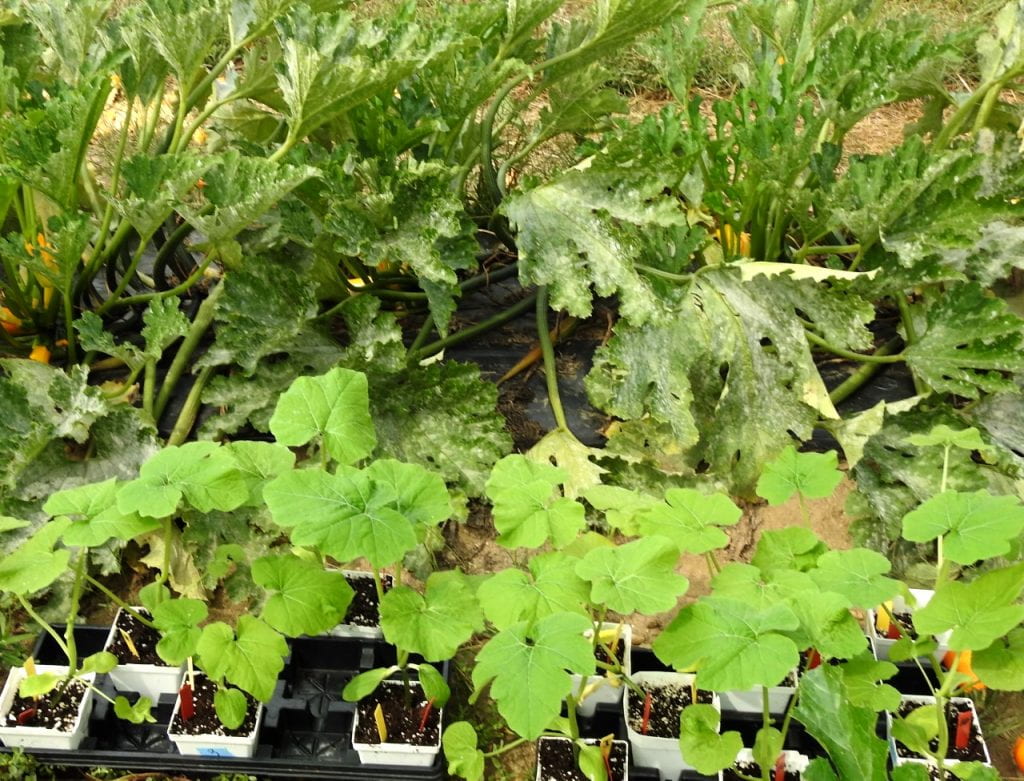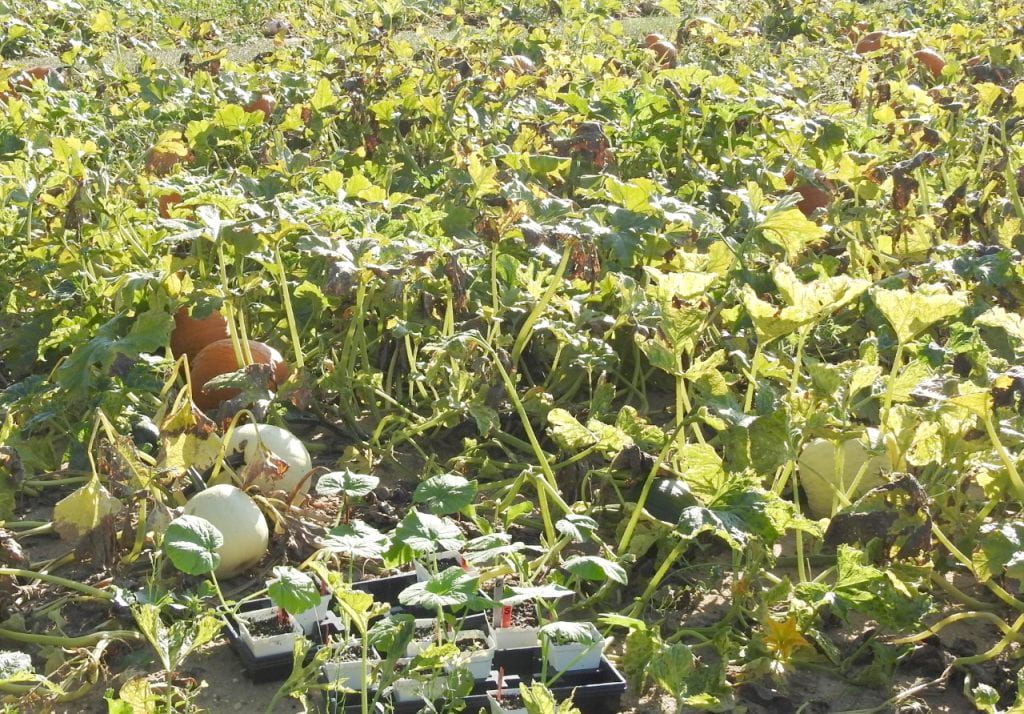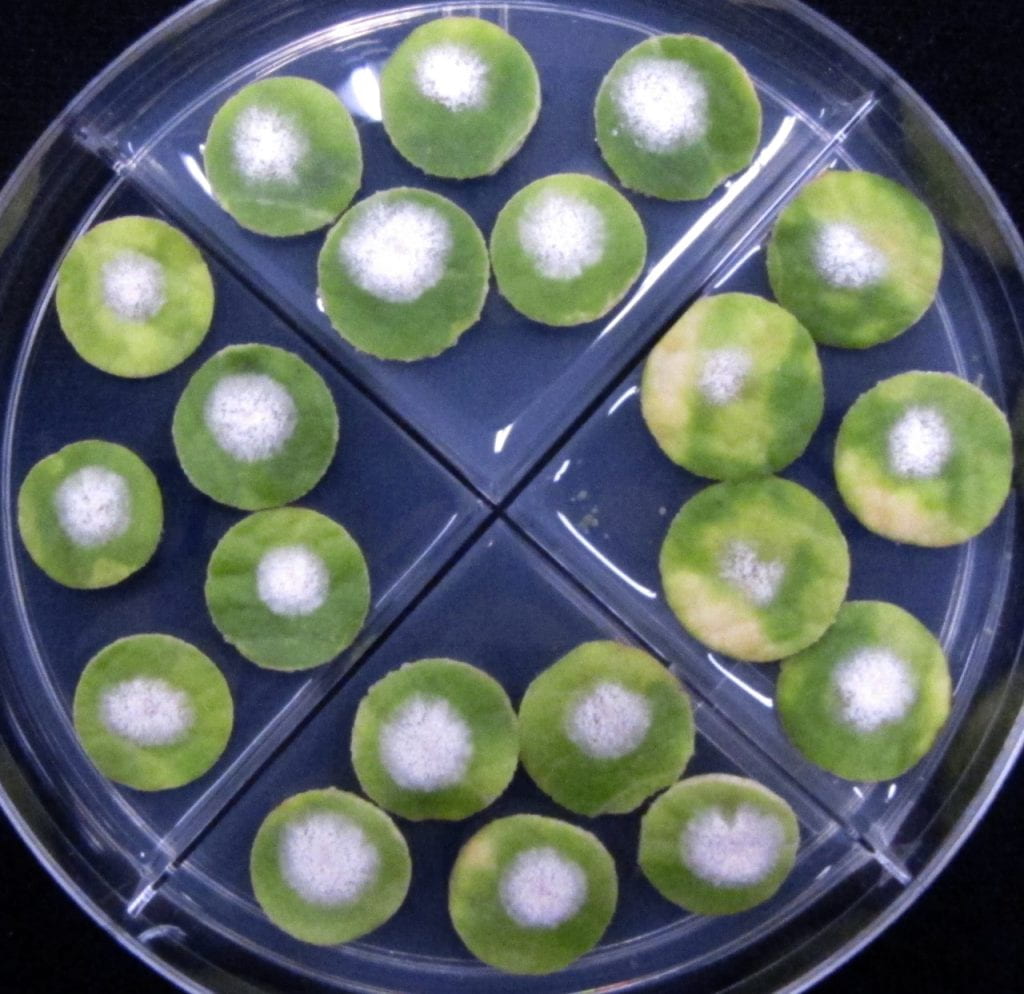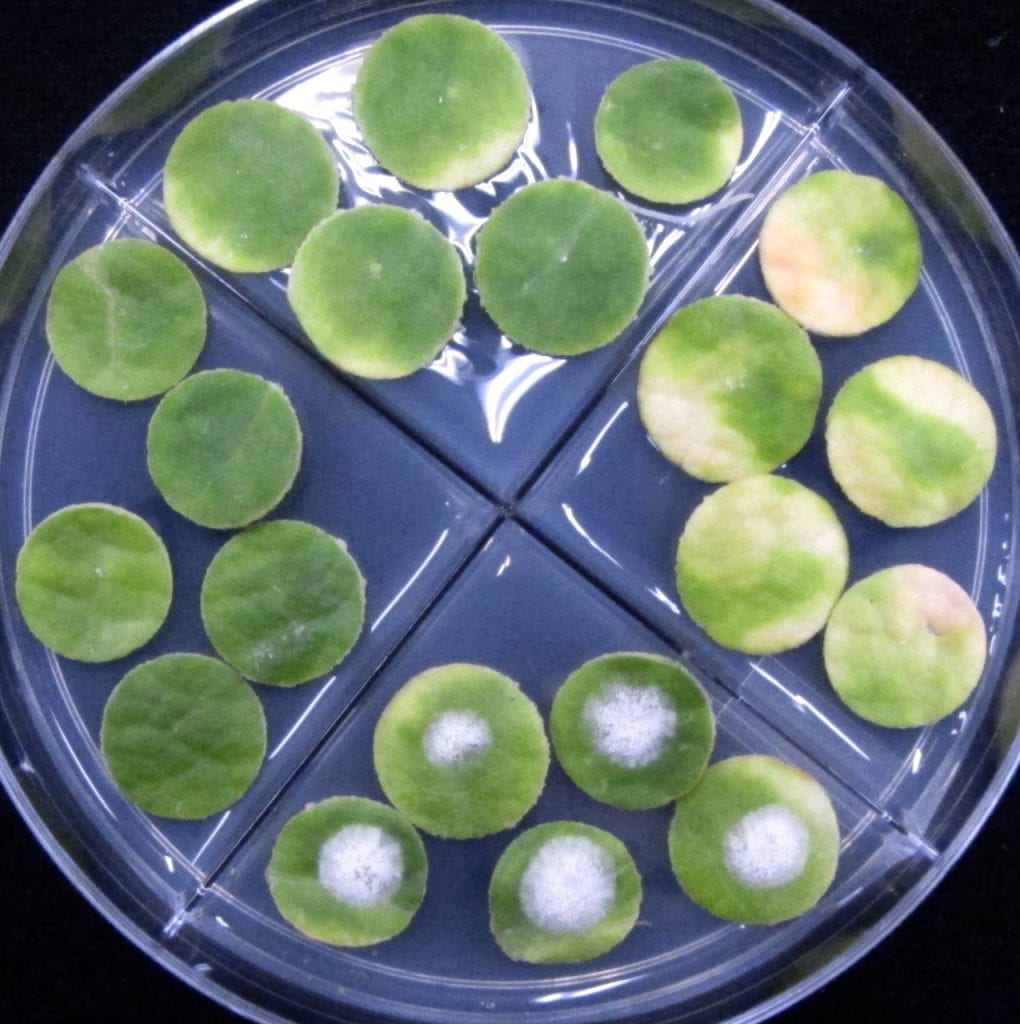Fungicides were evaluated and pathogen resistance to fungicides was examined in 2020, continuing research conducted in previous years. The overall goal of this work is to obtain information needed to guide management recommendations. Leaves affected by powdery mildew die prematurely which results in fewer fruit and/or fruit of low quality (prone to sunscald, poor flavor, poor storability). The main management tool for powdery mildew in most cucurbit crops is fungicides because disease resistant varieties typically do not suppress powdery mildew sufficiently (with the exception of cucumber) to be used alone (without fungicide applications) to prevent powdery mildew causing reduction in yield or fruit quality, and an integrated program with both tools is recommended to manage selection of pathogen strains able to overcome either one. Fungicide is needed on the lower surface of leaves where the pathogen develops best, which is best achieved with mobile fungicides able to move through leaves. Because these fungicides have targeted activity, they are prone to resistance development. The powdery mildew pathogen has a long history of evolving, in particular developing resistance to fungicides. Through research conducted at LIHREC resistance has been documented to fungicides in FRAC groups 1, 3, 7, 11, 13, and U6.
In the fungicide evaluation conducted each year at LIHREC, efficacy is determined for individual fungicides and for fungicide programs. Fungicides are tested alone applied weekly, which is not a recommended or labeled use pattern, in order to determine if resistance has developed impacting efficacy for registered products and to assess efficacy of new products. Not every fungicide chemistry prone to resistance is tested every year. These experiments have documented year-to-year variation in the pathogen population. In 2020 Proline provided exceptional control (99.5% control on lower leaf surfaces); Luna Experience, Quintec, Vivando, and Procure also performed well (89-95%) while Cevya, a new FRAC 3 fungicide, did not (44% at highest rate tested). The FRAC 7 active ingredient in Luna pre-mix fungicides (fluopyram) was shown to be highly effective through testing Luna Privilege, which has only fluopyram; it is not labeled for powdery mildew. In 2019 Vivando (FRAC code 50) was again the most effective single product tested providing control statistically similar to the alternation program (Vivando, Quintec, Proline), albeit numerically lower control (75 and 92% control on lower leaf surfaces). Quintec (13) was less effective (40%). This was the first year Quintec was not as effective as Vivando indicating that resistant isolates, which have been detected on LI since 2015, are becoming common enough to impact product efficacy when used exclusively. Quintec hopefully will continue to provide enough control to warrant limited inclusion in a fungicide program. In 2018 an efficacy assessment was made 2 weeks after the last application which documented that Vivando was the only fungicide treatment still controlling powdery mildew on lower leaf surfaces. Torino (U6) and Pristine (7+11) have not been tested since 2017 when they failed to control powdery mildew. In that evaluation Procure was statistically as effective as Vivando and Quintec although control was numerically lower (54, 80, and 72% control, respectively). In 2016 Quintec and Procure (3) were as effective as an alternation program (98, 91, and 97%) while Pristine was substantially less effective (43%).
A seedling fungicide sensitivity bioassay was used to detect resistance in cucurbit powdery mildew pathogen populations on Long Island in 2020. The bioassay entails treating potted seedlings at about the 3-leaf stage with different fungicide doses, putting them in field locations next to plants naturally affected by powdery mildew for a day, then keeping them in a greenhouse until symptoms developed when each leaf was assessed for severity based on percent coverage with visible symptoms. The bioassay was conducted twice. For the first, seedlings were treated on 4 Aug and put in a spring squash crop and research planting on 5 Aug. Similar to previous years, results provided clear evidence of resistance to Topsin M (FRAC 1) and Flint Extra (11) being at high frequencies in the pathogen populations: severity of powdery mildew on treated seedlings was not significantly less than on the untreated seedlings. These fungicides had not been used in either location, therefore resistance occurrence is not due to selection from fungicide use in the crops. More powdery mildew symptoms were observed on seedlings treated with Endura (7) and Torino (U6) than on seedlings treated with the most effective fungicide, Quintec (13), but at label rates (highest rate tested) they were both effective and not significantly different from Quintec. Quintec was highly effective at lowest rate tested while Torino was not. Rally (3) at low label rate (2.5 oz/A) was ineffective in the research planting where another DMI fungicide had been applied once. No mobile fungicide for powdery mildew were applied to the commercial crop.
Bioassay 2 seedlings were treated on 24 Sep and put in a research and two commercial plantings on 25 Sep. Resistance was again detected to FRAC 1 and 11 fungicides. Resistance was also detected to Endura and Torino, although these fungicides were not applied at any of these locations, which suggests resistant isolates are fit and able to compete. Luna Privilege (7) and Vivando (50) were very effective at labeled rate (highest rate tested). The binding site for fluopyram (active ingredient [AI] in Luna fungicides) differs from that for boscalid (AI in Endura and Pristine), which explains lack of cross resistance between these FRAC 7 fungicides. Variable results among locations in powdery mildew severity on seedlings treated with Endura and Torino suggests frequency of resistance to these fungicides was not uniform in P. xanthii populations occurring on Long Island in 2020. There appeared to be a small increase in frequency of resistance to Quintec and DMI fungicides (Rally used in the bioassay) in P. xanthii populations during the growing season. Results did not reflect fungicide used at the locations. Vivando, Proline, and protectant fungicides (copper and chlorothalonil) were used in one commercial planting for managing powdery mildew. Only protectant fungicides (sulfur, copper and chlorothalonil) were applied in the other.
These results combined with results from seedling bioassays conducted in 2018 and 2019 document that resistance to FRAC 1 and 11 chemistry is common early and late in the growing season while resistance to FRAC 7 (boscalid), 13 and U6 chemistry can be common, especially late in the growing season. Vivando and DMI fungicides remain the best options for managing powdery mildew on LI and elsewhere in the northeast where additional fungicides can be used (Gatten and Luna Experience).
Below: Fungicide-treated seedlings in commercial spring summer squash (first image) and pumpkin (second) crops with powdery mildew to determine what fungicides the pathogen there is resistant to.
A leaf disk bioassay was used to test for resistance in 57 cucurbit powdery mildew pathogen isolates collected at the end of the season from research plantings at LIHREC and commercial crops on LI and in eastern NY. The isolates were maintained on cotyledons in petri dishes and tested on disks cut from fungicide-treated cotyledons, which takes a couple months to complete for all the isolates and fungicide doses.
As in 2018 and 2019, there were isolates resistant to 3 chemistries: Endura (FRAC 7), Quintec (13), and Torino (U6). Notably, all isolates with resistance to Quintec were resistant to all 3 of these chemically different fungicides. They were from the two plantings where this fungicide was applied (10 isolates from a commercial planting in eastern NY and 1 from a research planting on LI; 19% of isolates tested) suggesting selection for resistance to Quintec from its use in these plantings and also that only multi-fungicide resistant isolates were present. There were isolates resistant only to Torino (23%) of these 3 chemistries and isolates resistant only to Endura (21%), but no isolates resistant to both Torino and Endura or resistant only to Quintec. All but 1 of the 13 isolates determined to be resistant only to Torino were obtained from LI, while all but 1 of the 12 isolates determined to be resistant only to Endura were obtained from eastern NY, suggesting regional differences in the pathogen populations, perhaps reflecting local fungicide use although Torino was not applied in any of the LI plantings samples and no FRAC 7 fungicides were applied in the eastern NY commercial plantings. No resistance to Endura, Quintec, or Torino was found in the commercial field on LI where Vivando (50) and Proline (3) were applied to manage powdery mildew.
Resistance to QoI fungicides (FRAC 11) was detected in all isolates, similar to previous years. This trait is remaining in the pathogen population although these fungicides have not been recommended for many years. QoI resistance was first detected in NY in 2002.
38.6% of the 57 isolates were able to grow on leaf disks treated with 50 ppm Luna Privilege. This fungicide contains fluopyram, an SDHI (FRAC 7) fungicide that binds differently from boscalid, the active ingredient in Endura and Pristine, thus these fungicides do not exhibit full cross resistance. Luna Privilege is used in the bioassays because it contains only fluopyram whereas the fungicides with fluopyram that are labeled for cucurbit powdery mildew, Luna Experience and Luna Sensation, contain another active ingredient (FRAC 3 and 11, respectively). Isolates able to tolerate 50 ppm Luna Privilege are not considered resistant because this dose is well below the field rate and these isolates have not been associated with control failure in the field. Of the 22 isolates tolerating 50 ppm Luna Privilege, 16 were resistant to Endura and 6 were sensitive to Endura. 7 isolates resistant to Endura were sensitive to 50 ppm Luna Privilege.
All isolates were sensitive to Vivando (50 ppm).
Below: Bioassay plates with leaf disks treated with Endura (left section of plate), Torino (top), and Quintec (right) all at field doses. Powdery mildew pathogen isolate tested in the first plate is resistant to all 3 fungicides while isolate in second plate was only able to grow on nontreated leaf disks (bottom).
Important information about fungicide resistance with implications for managing cucurbit powdery mildew were obtained through this research over the past few years.
- Frequency of resistant individuals in a pathogen population can increase substantially during one growing season.
- This shift in resistance is most evident in research plots where only one fungicide was applied. This is not a recommended use pattern for fungicides at risk for resistance because of the high selection pressure. It documents the value of alternating among fungicides to manage resistance.
- Shifts in resistance have also been detected in research plantings and commercial crops where fungicides were applied in an alternation program as recommended, as well as in plantings not treated with any fungicides at risk for resistance, which indicates resistant isolates are fit and able to compete with sensitive isolates.
- Several isolates have been documented with resistance to multiple fungicides, most notably FRAC code 1, 7, 11, 13, and U6. They came from research plots treated with single fungicides, alternation programs (including commercial crops), and occasionally from untreated plots. This represents a huge challenge to effectively managing fungicide resistance. An assumption behind the recommendation to alternate among chemistries is that it will be difficult for the pathogen to develop resistance to multiple chemistries and such isolates will likely be less fit and not able to compete well with sensitive isolates in the absence of fungicides. Fortunately the alternation programs do appear to be effective based on frequency of resistant isolates detected on plants treated with these programs compared to other plants.
Recommendations for managing cucurbit powdery mildew in 2021:
- Select resistant varieties. View tables of resistant varieties.
- Inspect crops routinely for symptoms beginning at the start of fruit development. The action threshold for starting applications is one leaf with symptoms out of 50 older leaves examined. Examine both surfaces of leaves. Starting treatment after this point will compromise control and promotes resistance development. Powdery mildew usually begins to develop around the start of fruit production. Protectant fungicides applied before detection may slow initial development.
- When powdery mildew is present, apply targeted fungicides weekly with protectant fungicides (sulfur, chlorothalonil, and oil are most effective) and alternate amongst available chemistry based on FRAC Group code. It is prudent to decide before the start of the growing season what products to use each week to have a plan in place ready to implement. Vivando can be applied up to 3 times with no more than 2 sequential applications. It is a good choice for the last application considering the long residual activity observed in the 2018 fungicide evaluation; it can also be used at any other time during the season.
On Long Island: DMI fungicides (FRAC 3) are also a good choice in the program, in particular for the first application. The most effective products include Procure and Proline, which is also labeled for Fusarium. Use highest label rates because the pathogen has developed moderate insensitivity to this fungicide group. Procure applied at its highest label rate provides a higher dose of active ingredient than the other FRAC 3 fungicides. Quintec is the next product to consider adding to the program. Resistant pathogen isolates have been detected at the end of the growing season since 2015 on Long Island but not early in the season when examined last year, thus Quintec is considered best used early in the season. An example program is: DMI, Quintec, Vivando, DMI, Vivando, Vivando. Aprovia Top (3 and 7) is another product that could be included. If more applications will be made, another application of a DMI fungicide could be added in the middle of the schedule. Due to common occurrence of resistance, powdery mildew cannot be controlled with Topsin M and QoI fungicides, which include Quadris, Cabrio and Flint.
Additional information for growers in upstate New York: Rhyme, Miravis Prime, and Luna Experience are additional FRAC 3 fungicides that can be used. Luna Experience has the advantage of having an additional active ingredient (7). Gatten (U13) is a new fungicide registered in NY in 2020 that is also not permitted used on LI. It can be applied twice.
Additional information for growers elsewhere: Gatten can be applied five times.
Additional information about managing cucurbit powdery mildew and table of fungicides are available on the Cornell Vegetables Cucurbit Powdery Mildew page .
Please Note: The specific directions on fungicide labels must be adhered to — they supersede these recommendations, if there is a conflict. Check labels for use restrictions. Any reference to commercial products, trade or brand names is for information only; no endorsement is intended.






